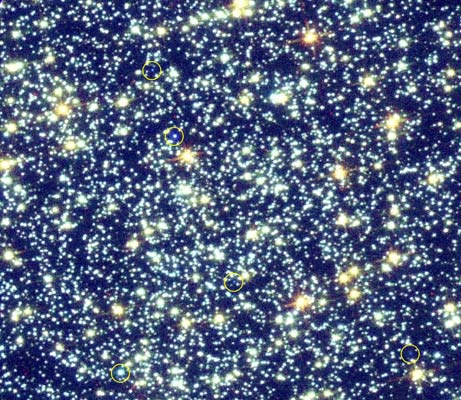
Old stars known as blue stragglers keep the appearance of youth by stealing mass from other stars, according to new research.
Christian Knigge of Southampton University in the U.K. and colleagues think most blue stragglers are members of binary star pairs that gradually pull matter from their partners.
This cosmic cannibalism allows smaller, aging stars to swell to sunlike proportions, extending their lives by hundreds of millions of years.
According to the study authors, the new finding refutes a leading theory that such rebirths were the results of stellar collisions.
"Personally, I always actually liked the idea ... that stars like our sun might literally smash into each other and form a new, more massive star," Knigge said of the opposing theory.
"Compared to that, even stellar cannibalism seems almost pedestrian."
Fountain of Youth
Astronomers have been puzzling over blue stragglers for more than five decades, because the stars are suspiciously young-looking and overweight for their ages.
Most blue stragglers are stars with the same to twice as much mass as our sun. They are found in globular clusters - gravitationally bound groups of roughly a hundred thousand stars that are thought to be about 12 billion years old.
A typical star similar in mass to the sun should live for only a few billion years. That means if a given blue straggler formed with the rest of its star cluster, it should have died billions of years ago, Knigge said.
To try and solve the mystery, Knigge and colleague examined blue stragglers in 56 globular clusters.
"Cluster cores containing more stars contain more blue stragglers," Knigge said. And the more massive a cluster, the higher number of binary pairs it contains.
"We see a lot of blue stragglers even in massive cores that have low collision rates," he added.
Michael Rich, an astrophysicist at the University of California, Los Angeles, said the paper reports "the first sensible correlation" between the number of blue stragglers and a property of globular clusters, in this case, core mass.
Rich noted that a 2007 study published in the journal Astronomy and Astrophysics used different methods to also suggest that blue stragglers arise from binary pairs instead of collisions.
"As the understanding of blue stragglers increases, it becomes possible to use these stars to understand important things about the origins of stellar populations," Rich added.
Life of a Straggler
Knigge and his team are now engaged in work to determine whether the binary pairs that tend to form blue stragglers have special life histories, such as close encounters or collisions with other binaries or single stars.
Study co-author Alison Sills, an astrophysicist at McMaster University in Ontario, is also investigating the way binaries can transform themselves into blue stragglers and what those blue stragglers should look like.
Finally, Knigge said, further observation with tools such as the Hubble Space Telescope should help confirm the team's findings.
"Determining parameters like spin rates and abundances for a large number of blue stragglers will definitely help unravel their origin," he said.



Reader Comments
to our Newsletter